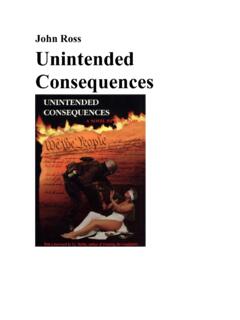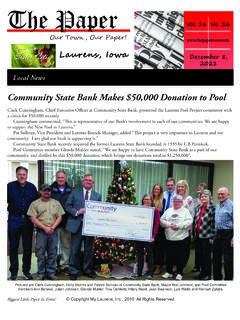Transcription of ISSUES IN ONLINE LEARNING: A CONCEPTUAL …
1 ISSUES IN ONLINE LEARNING: A CONCEPTUAL FRAMEWORK FOR COURSE DESIGN AND DELIVERY. Drew Parker Andrew Gemino Faculty of Business Administration Simon Fraser University Burnaby, British Columbia Canada V5A 1S6. The design and delivery of post-secondary courses is undergoing extraordinary change. Like many phenomena related to communication, it has undergone progressive evolution in the post-war era, with explosive growth in the five years of commercial Internet availability. A post-secondary course could traditionally be taken either by correspondence or in a conventional' place-based format; the Internet has created a confluence where courses can be delivered on a technological continuum.
2 Remote learners can now interactively participate in ONLINE seminars with some or all of the learning process delivered in an asynchronous mode. Course designs, in turn, can be a slightly modified version of past methods using novel technology for delivery or radically redesigned to accommodate some new media opportunity. This paper outlines the evolution and current revolution, discusses a challenge in the evaluation of effectiveness of alternative modes of delivery, and concludes with a proposed empirical design to approach the evaluation. 1. INTRODUCTION. Potential advantages of distance learning appeal to the crisis faced by public Canadian universities.
3 Funding cuts leading to fewer resources, greater demands for accountability, and newfound competition by private educators and other virtual' groundbreakers are prevalent. Queen's University1 and The Ivey School at the University of Western Ontario2 in Canada now offer Executive MBA programs via teleconferencing at locations across Canada, and are expanding into Asia and Europe. Athabasca University3 offers complete programs with technology support, as do several international institutions such as the University of Phoenix4 in the USA and the Open University5 in the United Kingdom. Most universities now have a growing distance education component.
4 The debate over the appropriateness of course delivery options without face to face' contact can be a heated one6, particularly if university policies are not updated to consider new ISSUES arising from alternative teaching configurations. ISSUES such as faculty workload, quality of the educational product, and transferability of program modules taken from different post-secondary providers offer mixed benefits to different institutional stakeholders. Pioneers in this area have been tending toward the implementation of entire programs7, rather than offering a mixed mode of place-based versus distance programs.
5 Adding to 1. 2. 3. 4. 5. 6. See, for example, Digital Diploma Mills' by David Noble at 7. For example Simon Fraser University's Graduate Diploma Program in Business Administration at: the complexity of the environment, there are even new publicly traded for-profit startup projects in Canada offering internet-based programs exclusively8 without the traditional accreditation process. Several hybrid offerings, however, are beginning to emerge. 2. CURRENT ONLINE OFFERINGS. ONLINE CONFERENCING. ONLINE conferencing tools support the creation and management of discussion groups. Tools offered include organized discussions, such as weekly topics or modules, data about participants, such as short resumes and personal information, and organization tools, such as grade records and access to files for up and downloading.
6 This area is newly supported by tools available on the Internet, which are evolving rapidly. VIRTUAL' SEMINARS. Traditional alternatives for university educational delivery have been between place based and correspondence based formats. The correspondence course format, which emerged after the Second World War, most closely resembles a predecessor of a contemporary virtual seminar. The virtual seminar differs from the correspondence course because the objectives, interaction, and timing are more closely representative of a regularly scheduled classroom seminar. Students can submit assignments according to particular due dates, exams can be offered, and participation can be expected and graded as a component of the course itself.
7 The Internet has offered many novel opportunities to handle transactions, and educational delivery is not exempt. The distinction between distance education' and ONLINE offerings' is being blurred by the growth of innovative technological options and creative new approaches to teaching. HYBRID MODELS. A university level course can be offered in an increasing option of formats. Traditional, place-based seminars, the status quo, have differed little over several hundred years. Instructional media support has modified the nature of the interactions, but the teacher/student relationship remains approximately the same as it traditionally has.
8 Lessons are given, notes taken, and exams and assignments used to evaluate students' performance. An approximately opposite model would be that of correspondence courses, where the content of a course is encapsulated into a materials package, the work is completed in a self-paced format, and assignments and examinations are submitted for grading. novel technological opportunities are providing an increasing number of hybrid alternatives to these extremes. Seminars can be enhanced with media such as ONLINE activities, notes and multimedia materials distributed in various ways, including the World Wide Web (www).
9 Faculty members are then made more available through telephone contact, electronic mail, some form of computer supported conferencing, or ONLINE chat/discussion sessions. Further along this continuum is a course where actual seminar content is substituted by a form of ONLINE learning. Several computer conferencing applications exist to support this concept, such as First Class9, or the Virtual University at Simon Fraser University10. These tools offer a comprehensive environment for ONLINE discussion based seminars. The seminars can be enhanced by technological support, providing levels of access to learning materials and faculty similar to that available to a placed based seminar.
10 Differences are substantial in terms of preparation and 8. Such as Unexus University at 9. FirstClass Systems Corporation at: 10. delivery, but learning objectives and possibilities appear, based on preliminary results, to be very similar. 3. THE COURSE DESIGN CHALLENGE. Assessment of learning from the new and different types of teaching formats made available by new telecommunications support is, as yet, preliminary and tentative. Arguments such as the Digital Diploma Mills' discussion suggest ONLINE learning is a copout' designed to marginalize the work of the professoriate and routinize and de-skill the learning process.






